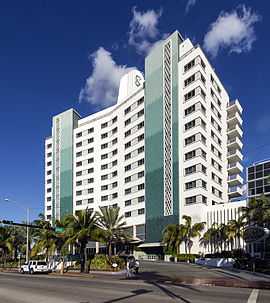Miami Modern architecture
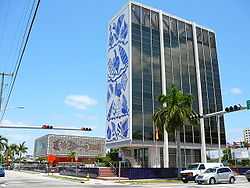
Miami Modernist architecture or better known as MiMo, is a style of architecture from the 1950s and 1960s that originated in Miami, Florida as a resort vernacular unique to Miami and Miami Beach. It was a popular response to the various modernist and post world war architectural movements that were taking place in other parts of the world, adding glamour, fun, and material excess to otherwise stark, minimalist, and efficient styles. Miami Modernism was heavily concentrated in Middle and Upper Miami Beach along Collins Avenue, as well as, along the Biscayne Boulevard corridor starting from around Midtown, through the Design District and into the Upper Eastside.
Today, the area along Biscayne Boulevard is the designated MiMo Biscayne Boulevard Historic District or also known as "MiMo on BiBo", for "Miami Modern on Biscayne Boulevard". MiMo Historic District runs roughly from 50th Street to 77th Street along Biscayne Boulevard, although MiMo can be found heavily in the Design District and Midtown. Many annual festivals are held to promote MiMo architecture, such as "Cinco de MiMo" a play on "Cinco de Mayo" in early May.
The umbrella term "Miami Modernism", or "MiMo" for short has only recently been coined to recognize this particular style native to Miami. The term was coined by Miami Beach resident Randall C. Robinson and interior designer Teri D'Amico. Prime examples of "MiMO" architecture include the Fontainebleau Hotel, Eden Roc, Seacoast Towers, Deauville, and Di Lido hotels by famed architect Morris Lapidus and Norman Giller's Carillon Hotel which was voted Miami Beach's "Hotel of the Year" in 1959, and the original Diplomat Hotel in Hollywood, Florida.
MiMo District
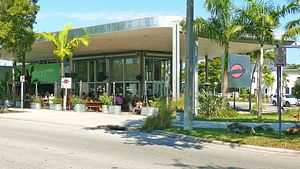
The MiMo District, also known as the Biscayne Boulevard Historic District, is a neighborhood in Miami. It lies within the larger enclave of Upper Eastside. It is bounded by the Little River to the north, Bay Point Estates to the south, the Florida East Coast Railway to the west, and Biscayne Bay to the east.[2]
The name is an acronym for Miami Modern Architecture. There are many examples of the architecture within the district.
Gallery
-
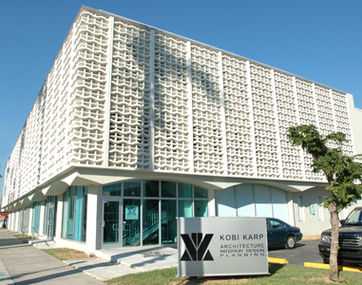
MiMo architecture along Miami's Biscayne Boulevard
-
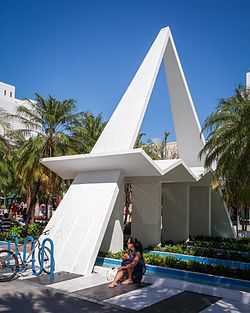
MiMo architectural follies on Lincoln Road
Partial list of MiMo buildings
- This list is incomplete; you can help by expanding it.
- Bacardi Building (Enrique Gutierrez, 1963) - 2100 Biscayne Boulevard
- King Cole Condominium (Melvin Grossman, 1961) - 900 Bay Dr.
- Biscayne Plaza Shopping Center (Robert Fitch Smith, 1953) - 7900 Biscayne Boulevard
- New Yorker Boutique Hotel (Norman Giller, 1953) - 6500 Biscayne Boulevard
- The Creek South Beach Motel (Originally Ankara Motel) (Reiff & Feldman, 1954) - 2360 Collins Avenue
- Crystal House (Morris Lapidus, 1960) - 5055 Collins Avenue
- Deco Palm Apartments (Gilbert Fein, 1958) – 6930 Rue Versailles
- Dupont Plaza Center (Petersen & Shuflin, 1957) - 300 Biscayne Boulevard Way (demolished in 2004 to give way to the EPIC Miami Residences and Hotel).[3]
- International Inn (Melvin Grossman, 1956) - 2301 Normandy Drive, Normandy Isle
- Jackie Gleason House (Lester Avery, 1959) – 2232 Alton Road
- Lincoln Road Mall (Morris Lapidus, 1960)
- Miami Herald (Naess & Murphy, 1960) – One Herald Plaza (Demolished Aug 2014 - Feb 2015)
- Pepsi-Cola Bottling Pavilion (Daverman & Associates c: 1965) -7777 NW 41st Street
- Shalimar Motel (Edwin Reeder, 1950) - 6200 Biscayne Boulevard
- Sinbad Motel (1953) - 6150 Biscayne Boulevard
- South Pacific Motel (1953) - 6300 Biscayne Boulevard
- Temple Menorah
- Thunderbird Motel (Norman Giller, 1955) - 18401 Collins Avenue
- Union Planters Bank (Francis Hoffman, 1958) – 1133 Normandy Drive
- Vagabond Motel (Robert Swartburg, 1953) - 7301 Biscayne Boulevard[4][5] (Reopened as the Vagabond Hotel in 2013)[6]
See also
References
- ↑ Wynwood Art District boundary map
- ↑ MiMo District neighborhood, detailed profile
- ↑ Mayor Manny Diaz & Commissioner Johnny Winton To Personally Complete The Demolition Of Dupont Plaza – Retrieved January 13, 2007
- ↑ MiMo: Miami Modern Revealed by Eric P Nash & Randall Robinson Jr (2004)
- ↑ Vagabond Motel at Florida Architecture: 100 Years, 100 Places
- ↑ The Vagabond Hotel
External links
- Vagabond Motel (Robert Swartburg, 1953)
- MiMo Historic District
- Miami Beach USA Article on MiMO Architecture with photos.
- Wides-Munoz, Laura (AP), Offbeat Miami: the Miami Modern District or MiMo, on ABC News Travel
- Vagabond Hotel
